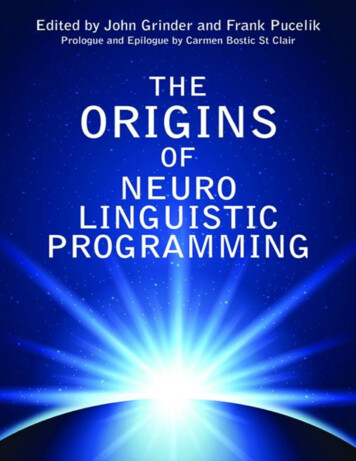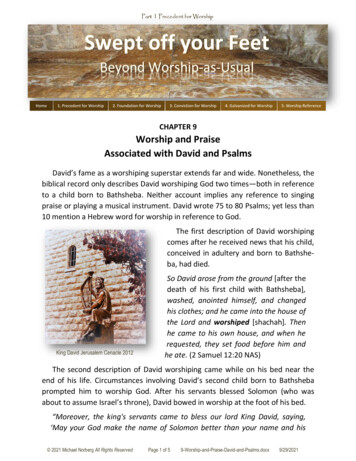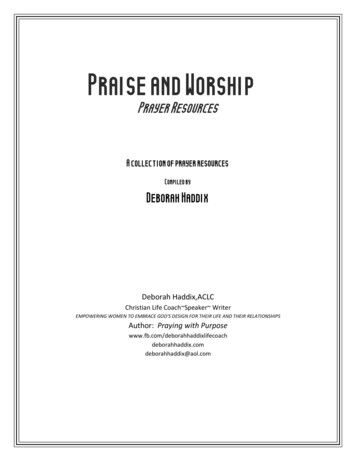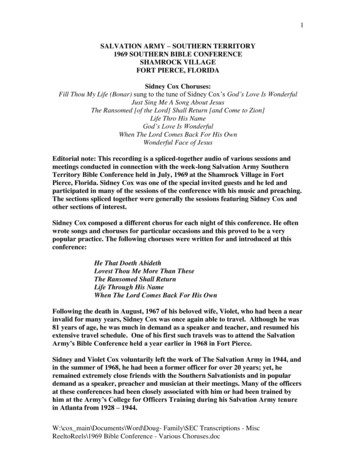
Transcription
Praise for The Origins of Neuro-Linguistic ProgrammingFinally! Forty-two years later the true origins of NLP are revealed which up to now have only been the subject ofmystery and legend. This is a must-read book for any student of NLP. In it we learn what actually happenedduring the first nine years of NLP and which set the stage for everything that has followed.Today everyone claims to be one of the developers of NLP. Now we learn who the real developers actuallywere. Further, we are reminded that the Meta Model is the genuine heart of NLP and that it can only bemastered through ongoing practice. We learn that there were three and not two creators of NLP and areintroduced to Frank Pucelik, who tragically many people in NLP have never heard of. Frank lives in Odessa in theUkraine and continues to pioneer developments in NLP for business and works with at-risk young people.John Grinder makes several points that the NLP world today desperately needs to hear and apply. He warns ofthe danger of content, categories, and pre-mature labeling and redirects us to focus on process. He alsoemphasizes the power of patterning, modeling, and testing in the creation of new applications.In short, devour this book, imitate the same rigorous methods that were used by the developers, and bring thisrigor to develop the next generation of NLP.Wyatt L. Woodsmall, PhD,NLP Master Trainer and Master ModelerDifferent voices, different histories this multiplicity of sometimes conflicting perspectives is a salutaryreminder that, as NLP has been at pains to point out, we each have our own map. Or as Robin Williams oncesaid, “Reality – what a concept!”Ian McDermott, founder of International Teaching SeminarsThis is a big important book for the distinct and radical field of NLP, its trainers, practitioners, and critics. Withcontributions from a core of the original developers from the 1970s, here is an inspiring, sometimescontradictory, multilayered account of the cultural and intellectual background, the key colorful characters, theplayful collaborations, the role of artistry and the creative unconscious, the adventures in modeling, research,and rigorous testing as well as some fine examples of early successful NLP applications.This book sets the scene for the real questions being posed: What really is NLP? Where is it going? Is it nowmerely a set of techniques you can learn by rote in a few days? Or does NLP still offer a subtle, skills-based, andfundamental opportunity to further expand and deepen our knowledge and practice of the arts of humancommunication, learning, and change?The Origins of Neuro-Linguistic Programming is an exceptional and essential read for everyone involved in NLPand interested in contributing to its future.Judith Lowe, MD and Principal Trainer ofNLP Training Institute/PPD Learning LtdThank you John Grinder and Frank Pucelik for your work in providing us with an account of how neuro-linguisticprogramming began as a seed and grew rapidly during the 1970s. NLP is now in its fifth decade and for the firsttime we have a reliable book that offers a history of NLP.
The Origins of Neuro-Linguistic Programming is both a story and collection of stories. The theme of the mainnarrative is the creation of NLP; the collection of stories is a rich anthology from the people who were there atthe beginning and others who came along after the foundation was in place. The accounts in this book capturethe commitment of Grinder, Bandler, and Pucelik as well as the spirited people they attracted to radicallyexperiment with patterns of human excellence.What makes this book exciting are the multiple voices narrating their personal experience of NLP during theheady days of 1970s. However, there is much more than history in these pages. If you focus at a deeper levelyou will find something very rich which is often missing in modern NLP – the fearlessness, the radicalism, thedesire to experiment, the commitment to model, and the willingness to undertake thousands of hours ofpractice. Without these elements we would not have NLP today. As you read and enjoy the voices from thesepages, you may want to consider how NLP would be more colorful in the current age if we embraced theattitude of the individuals who gave us so much in inspiring and creating the field of neuro-linguisticprogramming.Michael Carroll, founder of the NLP Academy andco-founder of the International Trainers Academy of NLPAn enjoyable, exciting, and informative adventure through the brilliant and quirky origins of NLP. This book is ahymn to the spirit of curiosity, creativity, collaboration, and adventure.Julian Russell, Executive Coach andDirector of The Life Talent ProgrammeWe have been waiting almost 40 years for this book – a first-hand account by some of the people who werethere at the beginning at one of the most creative times in history. The Origins of Neuro-Linguistic Programmingcan be enjoyed as several interwoven narratives, and you can model the modelers for their process ofdiscovery, testing, trial, and feedback. Whichever filter you choose, this engaging book will provide more aboutthe original spirit of NLP.James Lawley and Penny Tompkins, authors ofMetaphors in Mind: Transformation through Symbolic Modelling
To Richard BandlerYour voice is not here, only echoes of it. Your intelligence, your fearlessness, and your presence are apparent inmany of the narratives. We formed a team, the three of us, then the two of us, and against all odds, wesucceeded in creating something distinct and radical and set it free in the world.It was a great adventure!John GrinderFrank Pucelik
ContentsTitle PageDedicationPrologue A Suggestion to the Reader (Carmen Bostic-St. Clair)Introduction: Reflections on The Origins of Neuro-Linguistic Programming (John Grinder)The Fundamental StrategyPART 1Chapter 1: Lots of “Times,” Some Easy, Some Fun, Some Hard (R. Frank Pucelik)The “Originals” that Chose Not to Contribute to This Compilation of ChaptersChapter 2: My Road to NLP (Terry McClendon)Gestalt with RichardParts PartyThe Meta ModelHypnosis in the Santa Cruz MountainsOngoing DevelopmentCurrent ReflectionsChapter 3: The Early Days of NLP (Judith DeLozier)Chapter 4: Youth Services in Santa Cruz: The First NLP Community Testing Ground (David R. Wick)The Creation of Youth ServicesFinding Neuro-Linguistic ProgrammingNLP: The Wild and Crazy PeopleIntegrating NLP into Youth ServicesDid It Work?EpilogueChapter 5: My Parts Party: Early Dissociated State Therapy (Byron Lewis)UCSC Special Studies: EricAlba RoadAlba Road RevisitedThe ExorcismM.E.T.A. InstituteM.E.T.A. InternationalSubstance Abuse TreatmentPostscriptPART 2Introduction to Part 2 (John Grinder)The Love Song of NLP (Joyce Michaelson)
Chapter 6: The Middle of Know Where: My Early Days in NLP (Stephen Gilligan)Chapter 7: Commentary on “The Middle of Know Where” (John Grinder)Chapter 8: “It’s a Fresh Wind that Blows against the Empire” (James Eicher)A Voice of SignificancePrologue: ContextPart 1: The Family Ballet or “What, Specifically?”Part 2: Bateson SightingPart 3: Something about Tomato Plants, But It’s All a Bit FuzzyPart 4: Through the Corpus Callosum – From the Meta Model to the Milty Model: The Birth of NLPFrom Families to Organizations: My Personal and Professional JourneyChapter 9: Commentary on “It’s a Fresh Wind that Blows against the Empire” (John Grinder)Chapter 10: My Early History with NLP (Robert Dilts)Chapter 11: “The Answer, My Friend, is Blowin’ in the Wind” (John Grinder)Epilogue (Carmen Bostic-St. Clair)I. The Stage and the PlayersII. The Main Script: NLP ModelingIII. The Casting CallsIV. Group Improvisations: The First and Second Stages Utilized for Rehearsals of the PlayV. Unscripted PartsVI. The Epilogue of the PlayAppendicesAppendix 1Appendix 2Appendix 3BibliographyCopyright
PROLOGUEA Suggestion to the ReaderCarmen Bostic-St. ClairWelcome to the process of discovery. This book is a step back in time, composed of a series of articles writtentoday, some 40 years later, by individuals who came together in Santa Cruz, California during the years 1971–1979.A time when the Dow Jones Industrial Average was still under 1000 points, a new car cost less than 4,000, andthe kidnappers of Patricia Hearst were demanding 70 of food be given to every needy Californian. The time is1970s, an era of change and protest. Bob Marley’s song, “I Shot the Sheriff,” along with songs by PaulMcCartney and the Rolling Stones, could be heard blasting from the radios of brightly decorated VW vans; JesusChrist Superstar was playing at the single screen cinema crowded with long-haired men and women wearingfringes, bell bottoms, and fatigue boots – smells of clove, tobacco, and other substances filled the turbulent air.We ask you to enjoy the process of experiencing the discoveries as they unfold in the vivid and animateddescriptions by some of the individuals who have written articles for this book; as you enjoy, we ask you toengage in a process that is congruent and consistent with the experiential teaching practices which wereutilized by Richard Bandler, Frank Pucelik, and John Grinder during trainings on or near the University ofCalifornia at Santa Cruz.Words on paper do not really capture the full impact of a brief moment in time, so we are suggesting as youread that you utilize some of the well-known original processes of the field. We ask you to set the stage – to setyour computer, television, or whatever device on which you listen to music and tune it to the sounds of the 70s.While enveloped by these sounds, we invite you to transport yourself to the campus as described through theeyes of the writers; to gaze through the redwood forests and capture glints of the shimmering Pacific Oceanmelding with the horizon; while you are observing the gentle movement of the deer, listen for the call of the redtail hawk as you briskly rub your arms to ease the chill and become aware that the cool breeze carries the freshscent and taste of salt. You have arrived at the campus – step lightly into the shoes of these young, eagerindividuals as the adventure unfolds.The stories that you will read here are descriptions of experiences as remembered by the students andparticipants at training events that occurred during the creation by three men of the field known today as neurolinguistic programming (NLP). The field was created, the original patterns known as Classic Code NLP werelargely not created; rather the preponderance of these patterns were uncovered, assimilated, and explicatedthrough the process of NLP modeling. These are patterns which you and I perform unconsciously hundreds oftimes during a day. To provide you with a way of thinking about these unconsciously performed processes, weask you now, in this moment, to think about instances during your day when you replay the sound of someone’svoice and immediately recall their image. How frequently do you realize that you have unconsciously noted theposture, gestures, and general physiology of an acquaintance and find yourself surprised that you are able toanticipate what they are about to say and/or do? How many times a day do you spontaneously ask forspecificity of a noun or verb? How often in a business context, or when speaking to a detail-oriented person, doyou find yourself asking to see or hear an example of the bigger picture?The genius of creating a structure from these random natural intuitive processes and presenting them as explicitpatterns, was first published in the Structure of Magic, Volume I by Bandler and Grinder. The impact of this workis captured by Virginia Satir, as she writes in the Foreword to that book:Knowing what these elements are makes it possible to use them consciously and, thus, to have useful
methods for inducing change.One way to look at these explicit patterns is to view them as a coded keypad that can be used to open an ondemand system to use when and where we chose.If, at any point, while reading these articles you become puzzled by conflicting dates, processes, naming, orconnections, relax, enjoy your read. In the Epilogue I pull together such loose strands and braid them into acontinuity to provide an integrated description and possibly will solve some of those puzzles.W e could assume that you have had some introduction, experience, or background in Neuro-LinguisticProgramming, and therefore, have an interest in the creation of the field; this is one possible assumption,among many available. We have not made that assumption; experience in NLP is not a prerequisite. This bookis a drama about human beings who came together to make something new in the world.As I remind participants in my seminars, “a pattern discovered is a pattern owned by the discoverer.” Noticewithin these articles which writers seem to own their discovery. They were treated to excellent teachers whoutilized the inductive method of teaching; each of whom, I hope, embodied that process and transferred it, inturn to you – their own students.Carmen Bostic-St. ClairSan Francisco, CaliforniaOctober 2012
INTRODUCTIONReflections on The Origins ofNeuro-Linguistic ProgrammingJohn GrinderThis book has as its purpose a description of the origins of Neuro-Linguistic Programming (NLP). Note, pleasethe use of the indefinite article a in the phrase, a description of Neuro-Linguistic Programming. The co-editors ofthis book, Frank Pucelik and John Grinder, were two of the three prime movers in the creation of NLP and one orboth of them were present at the majority of the events described herein that define the origins of NLP. A thirdvoice, that of Richard Bandler, is not present in this book as he elected not to participate.The presentation of the origins of a field presents an interesting challenge for a number of reasons – amongthem, the fact that memory is reconstructive.Here is easily the most responsible act I, as an author and a co-editor, can offer you as the reader of this book.It takes the form of a warning. In approaching what you are about to read, keep in mind the following threepoints in what you encounter in this volume:1. A significant portion of what is described never happened!According the latest models of memory processes, memories are not stored as intact units to be retrievedand displayed. They are stored in distinct physical locations (the primary cortical areas for each of thecorresponding input channels) of the central nervous system; more specifically in separate representationalsystems. The connections among them are mediated by synesthesia circuitry.To remember, then, is to reassemble portions of experience stored in separate locations into what appears(in the present) to be a coherent representation of some experience in the past, one that satisfies thepresent intentions and requirements of the person doing the remembering. Such present intentions andrequirements of the person remembering operate as filters on the search mechanisms that reconstitute thememory.Thus, all such representations are ultimately, and profoundly, works of fiction. By the way, the fact that theyare fiction is NOT a disqualification, simply an epistemological warning about the veracity of what you arereading.So, what do you suppose is the probability of getting these pieces reassembled so as to match the archivalrepresentation of some omniscient, ever present (and non-existent) audio visual 360 degree recordingapparatus in the sky?2. Memory is selective and essentially incomplete!Thus, memories can be expected to vary as a function not only of the state, intentions, and filtering thatexisted at the time of the actual event but also as a function of state, present intentions, and filtering of theperson reconstructing the memory in the present. Distinct portions of the reconstruction being reported willbe identified and presented and others will not. As the state, intentions, and requirements of the personremembering shift, so will the representations of what occurred. Some of these differences will depend onthe granularity of the representation (its specificity) and whether it is confined to a specific logical type of
representation – description, interpretation, and evaluation (assuming that the person making thereconstruction, or indeed the reader, can make the distinction among these varying modes ofrepresentation). This is unlikely as the vast majority of the members of the fourth estate have yet to noticeor are unable or unwilling to respect.Test it for yourself – remember the last dinner you ate in a restaurant. OK, ready – make a representation ofwhat occurred Got it!Cool, but what about the color of the border of the menu? Did the servers actually present the fresh dishesfrom one side of the diner and remove the used dishes from the other side? How were the portions of thedinner arranged on the serving platters? Were the chargers color coordinated with the flowers on thesideboard (what sideboard!)? Who spoke first after the ordering was complete? Did the following speakers atthe table replicate the rhythm of the first speaker’s voice or was there a significant contrast? Did the volumeof sound in the restaurant rise and fall with a certain temporal frequency? Did the texture of the side dishescomplement the texture of the main dish? How clearly could you hear the sounds of the kitchen where yourfood was being prepared? How frequently did the people sitting beside each other mirror the others’ physicalmovements as compared with people facing one another either at the same table or the one to your left asyou sat at the table? Did the chairs you all sat in make a loud sound when moved during the seating ritual?Was the waiter/waitress right or left handed? Was the tablecloth arranged as a square or a diamond withrespect to the table it covered a flurry of questions, most of little or no interest for most people.The point here is that in reconstructing a memory, you are confronted with the task of selecting from amonga very large (although finite) set of possible things to represent. Those things that actually end up in yourreconstruction are there as an indicator of your intentions and interests, now, as you reconstruct thememory. In the provocations above about your dinner at the restaurant, I confined myself largely to physicalaspects of the event. What if we were to venture into the relationships implicit at that table and the complexoperations implied by these relationships? Now the situation gets even more complex. If you were able tocompare what you reconstructed with respect to the dinner in the restaurant with this archive, do yousuppose that your reconstruction would contain more or less than the archival file referred to above.Surprisingly, the answer is both – you would find a vast array of things that were not reconstructed in yourrepresentation and some things in your representation would NOT be present in the archive captured by thatubiquitous recording system in the sky.There are higher level differences that emerge in addition to the essentially incomplete and selective natureof your reconstruction of the dinner. Was your representation biased, focusing largely on the visual aspects ofthat dinner/restaurant event? Was any attention given to the sounds of the environment (the restaurant)?What about the tastes and combinations and sequences of tastes, the developing of various topics in theconversation, and how the feelings of the people at the table shifted with the development of theconversations about these various topics?3. Does it really matter what happened historically?What is the point of examining the historical development of something as complex as the birth of a newfield? Are you hoping to catch a glimpse of the processes of discovery, possibly even with the intention ofusing such processes in making comparable discoveries yourself? Are you so naive as to think that twohuman beings confronted with the “same” set of stimuli (experiences) will respond in the “same” way? Thesame’s are in quotes to remind you that the same set of stimuli are NOT the same when processed throughdistinct neurologies. Is it really relevant to you as a researcher to know how someone else with a completelydistinct background responded to the stimuli that were available at the origin of NLP? Do you really think thatplaying the music of and dancing to Congolese traditional rhythms, and training and riding Arabian trailhorses will assist you in becoming a better modeler? Does having developed a set of effective patternshelp guide young people out of the thick jungle of drugs towards a lighted path from which some of them canthen reach back and guide their former mates? Is it really an advantage to speak some eight languages; orhave a deep appreciation of battlefield injuries and the corresponding life-saving interventions required; or
know how to derail a train with a minimum of plastic explosives; or hit a golf ball 300 yards down the middleof the fairway; or to have a deep computational competency in automata theory; or how to rig a automaticwatering system for horse trough; or Personally, I don’t think so. But then, it is very dangerous to generalize from a sample of one.Yet, as I move around the globe offering training, conferences, and demonstrations, one of the most frequentquestions is the history question: What happened at the origin of the field now known as NLP? and How did ithappen? What ensues, if the person asked is willing to accept the question, is a series of bedtime stories,meeting the requirements of the speaker’s present intentions in presenting themselves to strengthen the imageof whoever the speaker is and what s/he wishes the audience to carry away with them.So, step back a moment here before plunging into this maelstrom and ask yourself the obvious question:What is the relationship, if any, between the technology of modeling and the history of discovery,assimilation, and coding of patterning in the field now known as NLP?Isn’t the point of this simple but difficult adventure called the modeling of genius to detect, assimilateunconsciously, code, and disseminate the patterning of geniuses? If this cycle of deep learning has any point, itis to make available the patterning of geniuses in a learnable form that integrates these patterns of genius intothe performance of people wishing to achieve higher quality and more effective results in their worlds ofapplication. This results in the raising of the bar in that profession. For example, the modeling of Dr. MiltonErickson required some 10 months or so between first contact and the coding of the patterning (see Patterns ofthe Hypnotic Techniques of Milton H. Erickson, M.D. Volumes I and II).1 How many people have the time (10months) as well as the tolerance for the inherent ambiguity of the task of modeling and the competency to codethe assimilated patterns into a description that would allow others to gain access to these patterns without thisenormous investment of time and talent?In medieval Europe, the accumulated tacit knowledge of various professions, say, for example, of masonry, waspassed from master to apprentice through direct modeling – there were no shortcuts. The apprentice masonprepared the site, carried the materials, did the clean up, and whilst doing all this, if this apprentice were tosucceed in becoming a mason, he would notice and mark how, specifically, the master mason approached thevarious aspects of actually building that structure, setting up that foundation, and executing the plans of thearchitect.I recognize that the depth of integration of the patterning is quite distinct (at least initially) as a function of themethod of assimilation. If learning the patterning is accomplished inductively and through unconsciousassimilation, the patterns belong in a deep sense to the learner. Such a learner then has the leisure to revisitsuch patterns and may then ferret out the essential elements of the patterns and their sequencing – the formalpattern itself or some functional equivalent.Those learners following a conscious approach will certainly upgrade their game; whether they ever achieve thedepth of integration of patterning arrived at inductively is an open question. In our present context, few people,if anyone, are prepared to enter the strange and disorienting world of deep inductive learning, thus, the niche ofmodeler emerges.So, what will you do with these reconstructed tales flowing down through the decades since their actualoccurrence, and channeled through the intentions, interests, and self-images of the people offering theserepresentations?Good question!The Fundamental StrategyFrank and I have considered how to manage these issues. We have settled on a specific strategy. We have
determined to pursue the minimization of these particular classes of distortion by calling upon a large number ofpeople who were physically present and participated in or observed some of the events that are hereindescribed. A few are names that are widely recognized in the present day field of NLP; most are people who areunknown and largely inactive with respect to the patterning of the NLP of today – people who have no particularclear known agenda. Mark carefully what they report.You will find in this book the voices of people who moved resolutely, wandered, and/or often stumbled (most ofall the co-authors of this book) through these events, each of whom carried with them specific personal agendasand perceptual filters which ensured that their perceptions and thus subsequently their reconstructed memoriesof these events would be quite distinct, especially with the passage of time (now some 40 years). Many of thesedifferences arise through the ubiquitous and selective perceptual filtering that necessarily results from thestrong limitations of the bandwidth of consciousness (7 or – chunks of information).I would venture that few of the distortions that occur in such reconstructions are deliberate. This lack of explicitawareness of the filtering and its consequences, and the unconsciously motivated personal agendas of thepeople responsible for these deviations from what actually happened (now largely unknowable), makes suchdistortions all the more problematic, both with respect to the task of discovering what the distortion is/was andwhat it is/was a distortion of – that is, deviations from what actually happened.But surely one of the most obvious and powerful conclusions from the development and deployment ofpatterning over the last four decades in NLP, and easily verified in the reader’s own experience, is theastonishing diversity in the descriptions that emerge from any single event when described from the distinctperceptual positions of the people who directly participated in or witnessed the event in question.Indeed, I would caution the reader to consider the following: the more prominent the name/reputation of thewriter of the description, the more likely the distortions (operationally defined as deviations from acorrespondence with the record captured by great 360 degree audio/ video recorder in the sky – whichfortunately or unfortunately does not exist). This is the sense of unknowable as in the paragraph two above thisone. Note please that this applies with full force to the words that you are presently reading.This is as accurate a statement for a relatively common event, such as whose idea was it, really, to organizethat birthday party for a mutual friend, as it is for that rare event – the creation of a new field of patterning suchas NLP. None of it is to be taken at face value.There are two distinct issues here. First, anyone with an appropriate background and some thought cancomment on what they perceive as the predecessors of NLP or any other set of developed patterns. Certainly,practitioners of the Philosophy of Science have done this service for many branches of science (see especiallythe fine work of Thomas Kuhn in The Structure of Scientific Revolutions on the development of portions ofmodern physics2). Through their research into the birth and development of what later became incorporatedinto standard models or sets of patterning, these practitioners have succeeded in connecting discrete andheretofore unconnected work, sometimes in a single field, sometimes across fields, that had previously beenconsidered distinct. Such studies can be highly useful and instructive.This is a distinct issue from what the creator or co-creators of a discipline had access to, what they were awareof at the time and in the context of the creation of that discipline. It is interesting to consider the differencesbetween these two issues as captured by the following two questions.The first question is:Where did the ideas that turn up in some new model or set of patterns come from historically?This is surely an issue worthy of the attention of researchers with a synthetic bent – a history of thedevelopment of the ideas involved. As examples of the high value of such work, I cite two cases from Kuhn. Thefirst is from The Structure of Scientific Revolutions:With scientific observation the scientist can have no recourse above or beyond what he sees with his eyes and instruments. If there were
some higher authority by recourse to which his vision might be shown to have shifted, then that authority would itself become the source ofhis data, and the behavior of his visions would become a source of problems. The period during which light was “sometimes a wave andsometimes a particle” – was a period of crisis, a period where something was wrong – and it ended only with the development of wavemechanics and the realization that light was a self-consistent entity different from both waves and particles. In the sciences, therefore, ifperceptual switches accompany paradigm changes, we may not expect scientists to attest to these changes directly. Looking at the moon,the convert to Copernicanism
The Origins of Neuro-Linguistic Programming is both a story and collection of stories. The theme of the main narrative is the creation of NLP; the collection of stories is a rich anthology from the people who were there at the beginning and others who came along after the f










